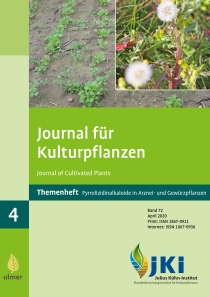NIRS-based detection and removal of pyrrolizidine alkaloid containing weeds in crop plants after harvest – PA-NIRSort
DOI:
https://doi.org/10.5073/JfK.2020.04.05Keywords:
near infrared spectroscopy, image analysis, pyrrolizidine alkaloids, medicinal plants, aromatic plants, sorting technology, reduction of PA-contaminationAbstract
The general objective of the project is the development of an efficient sorting system based on hyperspectral near-infrared spectroscopy (NIRS) for the detection and separation of impurities by pyrrolizidine alkaloid (PA)-containing plant-derived contaminations in cultural plants, e.g. medicinal and aromatic plants. PAs are liver-toxic secondary metabolites that protect plants from predators and have drawn more attention in recent years after harmful concentrations were found in medicinal teas. By now, the German Federal Institute for Drugs and Medical Devices (BfArM) has published strict PA limit values because medicinal plants can be contaminated with PA-containing weeds such as various types of ragwort, groundsel, common viper's head, field forget-me-not, common dog's tongue, water-east or borage and thus, potentially endanger people with medicinal or aromatic teas (BfArM, 2016). Four to five PA-containing plants e.g of Senecio vulgaris per hectare are sufficient to contaminate one ton of the drug by exceeding the critical value of maximum uptake of 0,007 μg PA/kg body weight per day published by HMPC.
The planned process will analyze fresh and dried plant material on a flat-conveyer using hyperspectral NIR spectroscopy to detect impurities in the crop. After identification, contaminants should be removed by a sorting technique, e.g. using compressed air pulses. Similar systems have already been established in plastic waste sorting and quality control, for example for grapes (Freund et al., 2015). The aim is to achieve a high throughput of up to 1.5 t/h with such an automated sorting technology, the health risks posed by PA-contaminated medicinal plant products could be reduced ecologically and economically efficient for cultivation and processing of medicinal plants. This would also mean safeguarding high-quality and competitive plant-derived drug production in Germany.
First results show that a classification of target plant species and contaminating groundsel using NIR spectroscopy succeeds for various medicinal plants. To be able to carry out such image analyses in real-time, the amount of data to be processed will be reduced to the decisive factors using multifactorial data analysis.
Downloads
Published
Issue
Section
License
The content of the journal is licensed under the Creative Commons Attribution 4.0 License. Any user is free to share and adapt (remix, transform, build upon) the content as long as the original publication is attributed (authors, title, year, journal, issue, pages).
The copyright of the published work remains with the authors. The authors grant the Journal of Cultivated Plants, the Julius Kühn-Institut and the OpenAgrar repository the non-exclusive right to distribute and exploit the work.







